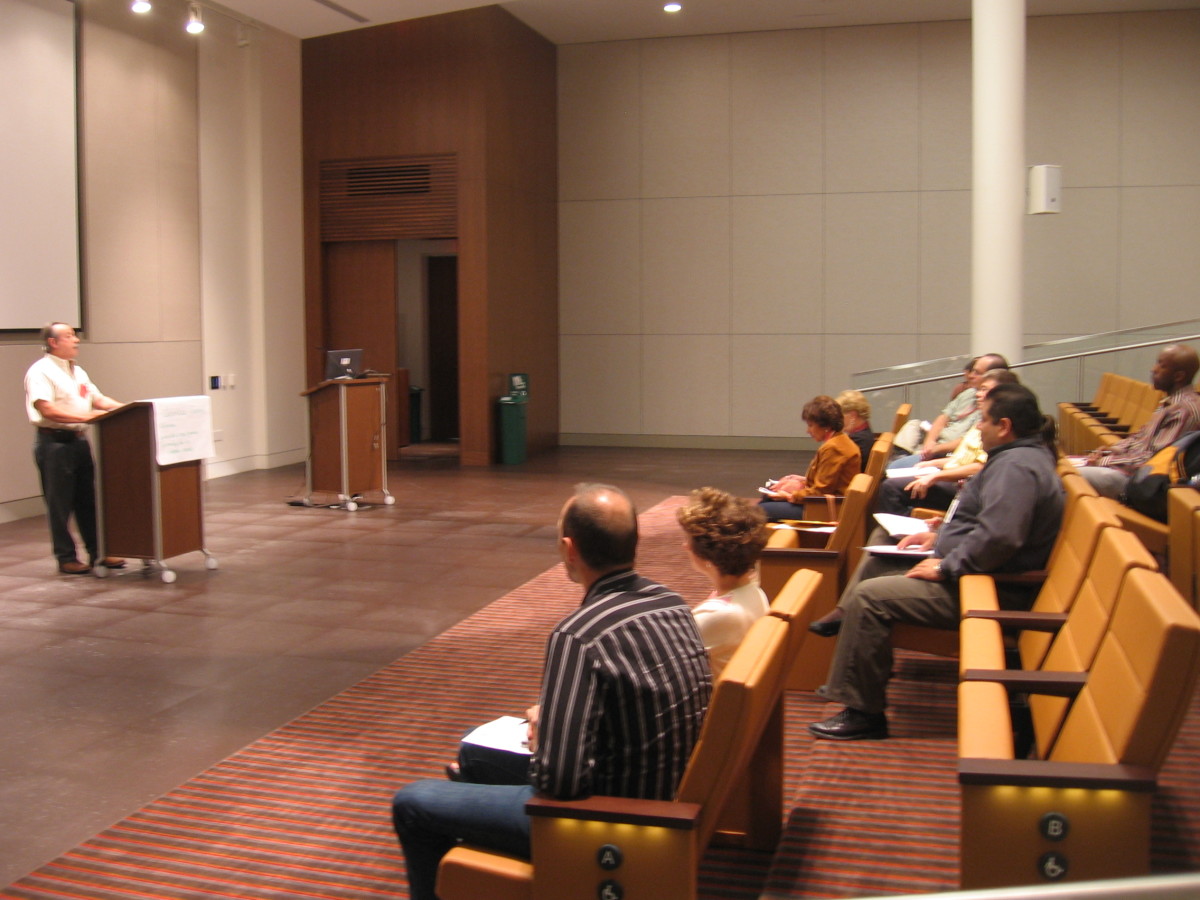Public Speaking and Communications - Proper Diction Enunciation and Diction Exercise
As a business professional, our voice is one of our main tools. How can we improve our voice and mimic the media professionals who have great voices - great vocal tone, pitch and diction? Here is a paper from an outstanding media professional who shares his inside trade secrets.
Like all great skills, it takes time, patience and practice. This article walks us through all the pieces that make up our voices. Like sailing, if we trim our sail properly, we can sail quicker and smoother. So too, with a great voice - we will command more authority and respect with a great voice. So journey with us as we learn how to trim our sail for a great voice!

Deepen Your Voice
About the Author - Darrel Burnett
The majority of the written material provided was principally authored by Darrel Burnett who is a former network sports anchor.
Mr. Burnett anchored, covered and most major sporting events during his career including Super Bowls, Play-By-Play for NFL games, World Series, Olympic Trials, The Pan-American Games and the World Figure Skating Championships.
He has subsequently mentored and trained news and sports anchors throughout the United States. Currently, he is an executive in the medical health field. He continues to enjoy moderation of health issues and is commonly invited to speak at national and international conferences.
He served as Master of Ceremonies for the Congressional Medal of Honor Convention in Green Bay, Wisconsin and also served as Master of Ceremonies for the commissioning of the USS Green Bay. He resides in Green Bay, WI.
An Engaging Voice Is the Mark of a Media Professional
Prepared By: Darrel Burnett
Philosophy
An engaging voice maintains the attention of the listener
regardless of the content or venue. An engaging voice varies tone and pacing to
capture the value in every word.
An individual’s speech content may be excellent but unless you deliver it in an interesting way, few people will actively listen and most will tune out after a few short minutes. An expressive energized voice keeps them turned on.
I. Vocal Variety - The Essentials - Pitch, Tone, Volume and Rate
Vocal variety is simply achieved by focusing on pitch, tone, volume and rate.
A. Pitch
To understand pitch , think of music. It has high and low notes just like people's voices. A woman’s voice naturally tends to be higher. By adding a lower register a woman will have a very pleasant variable voice. In contrast when the vocal range is very small, the result is a monotone voice.
B. Tone
Tone refers to the emotional content carried by our voices. The magic isn’t in the words themselves rather the magic is 'how' we say those words.
Example: Have you ever had someone misinterpret an e-mail? The reason is because the reader was left to interpret “the tone” of the e-mail. That is why it is so important to use your voice to convey the message. This is critical as a news reporter.
C. Volume and Rate
Volume when used properly holds
the attention of the listener. Volume is particularly effective for ministers,
priests and rabbis as they give their messages. By increasing volume at certain
critical times it jolts the listeners creating the necessary effect of
listening. Pay attention to how fast or slow you speak when you are around
friends vs. when you are around a person you are meeting for the first time or
a professional relationship. Chances are your rate of speech varies due to your
level of comfort. Practice varying your speed and volume in all situations.
II. Vocal Exercises:
A. Pitch Exercise
Take a deep breath in and begin speaking on a topic of your choice until you run out of breath. Remain on the SAME note all the time. When you have finished, choose another note either higher or lower and repeat the exercise. Pay careful attention to the effect it has on you! Notice the difference when the pitch of your voice is higher and then lower. You will likely feel a “physical” difference as well as an emotional difference.
Pitch Experimentation:
Speak the sentences below in your high, middle and low pitch range. Notice what
happens to the intensity and the way you perceive the emotional content
of the sentences. There will be a distinct variation between each.
The economy is depressed.
I want a new car.
This dinner is delicious.
People should love their neighbors as themselves.
B. Emotional Tone Exercises
The Emotional Sandwich Exercise: Here we will learn how tone and inflection change the meaning of the very same words.
Repeat the words "Hub Pages" in the
following ways.
- Angrily
- Happily
- Sadly
- Lovingly
- Despairingly
- Laughingly
- Importantly
- Slyly
- Snidely
- Shyly
This is a fantastic exercise to share with a partner. Take turn about giving each other the way to say the phrase. Repeat until you run out of variations. Your focus should be to listen for emotional truth or believability!
Using a Book:
Open any book at any page. Select a style * or emotion and read aloud whatever is there. Sustain each feeling state for at least a
minute. Listen carefully to yourself to make sure you are treating each word
with the appropriate emotion.
Reading childrens' stories is an
excellent tool for capturing emotion since most are written to hold the
attention of a small child and are designed to be read out loud. As you
read it aloud make sure your voice carries the meaning of the words. If the passage uses a scary voice read in
a scary voice etc. When you listen to yourself, be alert for areas to improve.
Record it again with the changes.
VOLUME:
The skill involved with getting louder or softer is to maintain tone and pitch
while altering the sound level. Many people lose them both, particularly when
they get louder. Shouting may guarantee you get heard but it doesn't usually
mean heard with pleasure. The other down-side to shouting is straining your
voice. Good breath control
is one of major keys to upping the volume while maintaining tone and pitch.
D. Breathing Exercise
Practice breathing using your Diaphragm:
- Stand in front of a mirror.
- Spread your feet shoulder width apart.
- Neck back, Chin down
- Place one hand on your stomach. Breathe in. You should feel your stomach rising and then breathe out. This time your stomach falls. Watch your shoulders. If they rise and fall noticeably you are most likely breathing off the top of your lungs! Try until you can feel a definite rise and fall of your stomach. Keep relaxed.
Laugh Out-loud:
- Stand in front of your mirror breathing normally.
- As you breathe out begin a series of Ha-ha-ha-ha's until all your breath is used.
- Breathe in and start again. Vary your laughter. Make it louder, make it quiet and then build it up again.
- Repeat until you are laughing loudly and easily without any strain.
D. Enunciation Exercise
This
particular passage comes from Gilbert and Sullivan's 'The Pirates of Penzance'.
the verbiage is challenging and an excellent exercise in controlled speech
which will greatly enhance your enunciation and force you to slow down and speak
clearly.
'I am the very pattern of a modern Major-General;
I've information vegetable, animal, and mineral;
I know the Kings of England, and I quote the fights historical,
From Marathon to Waterloo, in order categorical;
I'm very well acquainted too with matters mathematical,
I understand equations, both simple and quadratic,
About binomial theorem I'm teeming with a lot o' news,
With many cheerful facts about the square of the hypotenuse.
I'm very good at integral and differential calculus,
I know the scientific names of beings animalcules,
In short, in matters vegetable, animal,
and mineral,
I am the very model of a modern Major-General.'
Diction Exercise
21 Accents in 2 1/2 Minutes - Diction Made Fun!
Voice School - How to Improve Your Voice - Lessons in Vocal Diction
Voice School and Exercise
1. Open the mouth - articulate - let's hear the breath
2. Get the air in so you can get the air out, use the diagram - vocal Kung Fu
3. If you think you are talking too slow you are probably talking just right
4. On the phone, remember all they can hear is your voice
Frank Sinatra learned his phases by swimming under water by learning how long he could hold his breath.
Check out the student and hear the results!
Vocal Diction Definition - What Is It?
"Vocal Diction is the accent, inflection, intonation and speech-sound quality manifested by a communicator."
Vocal diction is the delivery other than word choice including but not limited to:
- pitch,
- tone,
- speed,
- enunciation.
Trim Your Sail - Work on Your Vocal Diction
Great vocal diction is the mark of a media professional. Your voice is one of your greatest tools - for home and for work. Being clear, being understood and being respected is an important part of our lives - both at home and at work.
Pitch, tone, speed, enunciation - all contribute beyond word choice to your presentation. Be the very best you can be - great professionals have great voice. Cultivate your voice, refine your diction, notice your enunciation, vary your speed, match your emotions to your word choice and circumstances.
3 Take A Ways to Improve Your Vocal Diction - Improve Your Voice



#1 Great Professionals Have Great Voices
Watching the media professionals, listening to famous actors and actresses, and identifying what vocal tones and diction work for them.
#2 Practice Your Voice - Step by Step
Follow the exercises listed here. Know your strengths and your weaknesses. Use a recording device - preferably a video.
Incorporate your favorites and take the best of your favorites and make it your own.
#3 Learn to Love Your Voice
Yes, it is hard at first. Learn your own voice. Change your voice - refine it so that it is the very best possible voice and presentation. With some work, you will learn to love your voice.
Have you ever worked on your diction? Do you have control of your voice?
Diction on Amazon
© 2010 Ken Kline






